Convincing people to sign up for your email list is only half the battle. The other half entails keeping your subscribers engaged by providing interesting and valuable email content.
Despite your efforts to keep your email personalized and useful, some subscribers won’t be bothered to open or click, no matter how flawless your new email template looks or how many cat photos you’ve included as attachments.
It’s a lot like romantic relationships. There’s the honeymoon phase when you can’t seem to stomach the thought of being apart from your new lover for more than a day. Eventually, the interest wanes from both parties as the relationship progresses.
Now that the honeymoon phase is over and the “spark” isn’t there anymore, should you give up?
The short answer is no. And you’re not alone. In fact, an average email list loses 25 percent of its active contacts every year.
What’s a savvy inbound marketer like you to do? It’s high time you win their hearts back through a re-engagement strategy we’ve outlined below!
Why Bother With Re-engagement In the First Place?
While there’s no use convincing an ex-lover for a second chance when they’ve made up their minds, a subscriber who has lost interest by not opening or clicking one of your emails hasn’t made up their minds yet. If they did, they’d be quick to click the unsubscribe button.
This is why you have to give re-engagement a chance. Rekindle your relationship with unengaged subscribers and turn them into loyal, raving customers once again.
This Campaign Monitor post also explains why you should not throw in the towel just yet. A Gmail team member explained that for your emails not to be blacklisted or flagged as spam by one of their servers, they have to see “evidence that your recipients love, or at the very least, want your messages, for them to reach the inbox.” A sound re-engagement strategy will help accomplish this because subscribers will be enticed to click, open, and even reply to your email. If the folks at Gmail are serious about it, it's likely other email service providers will follow suit.
5 Steps to Win Back Disengaged Subscribers and Lost Leads
Here are five ways to help kick-start your email re-engagement strategy and regain lost leads.
1. Remind them of the value you offer.
Marketing these days means you have to continually work hard to engage with subscribers and turn them to potential customers by tailoring your offers to meet their needs.
As part of your re-engagement campaign, re-introduce yourself to prospects and remind them of the value you offer. Rethink your email content and stop sending those sales pitches.
The re-engagement email by JetBlue below is a great example of what it means to remind your prospects of the value of keeping you in their inbox.
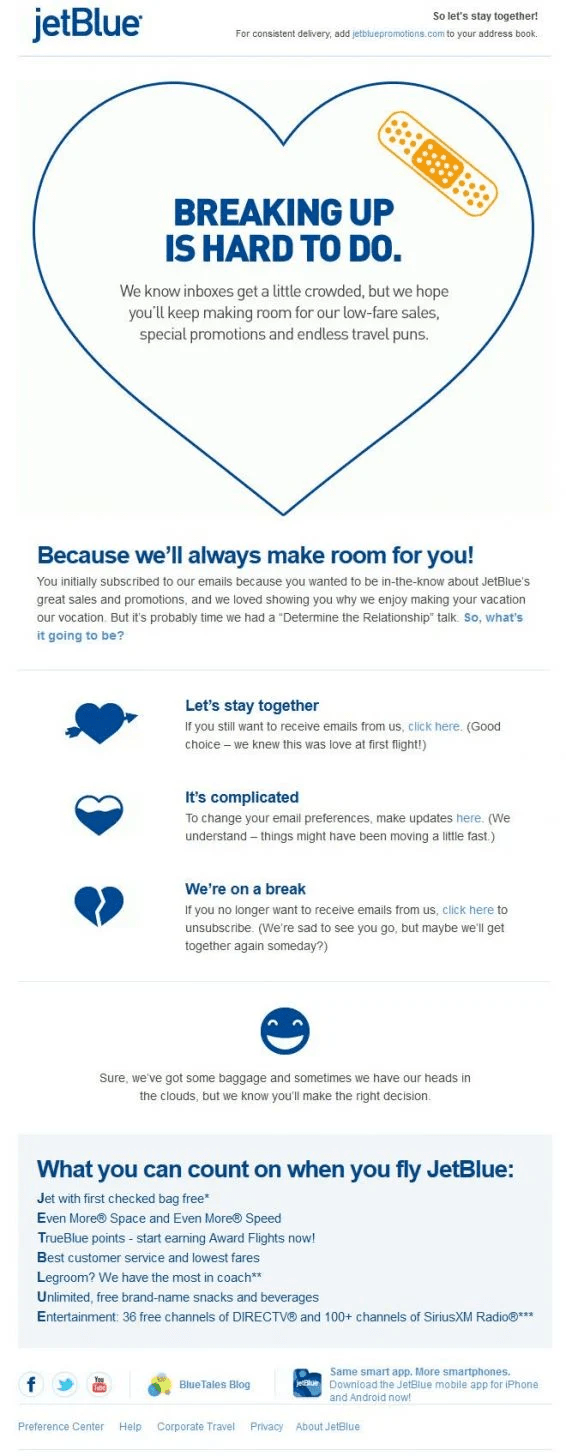
By outlining the specific benefits of keeping tabs of your email updates, subscribers will be more receptive to your future emails.
2. Offer an incentive.
Everybody wants something for free, both online and offline. This is why discount vouchers and other incentive programs never go out of style. Why not use the same approach in your re-engagement strategy? Give them an offer they can’t refuse!
When using this approach, remember, the best freebies and incentives are the ones that scream significant value to your customers. Take it from the Not On the High Street team below.
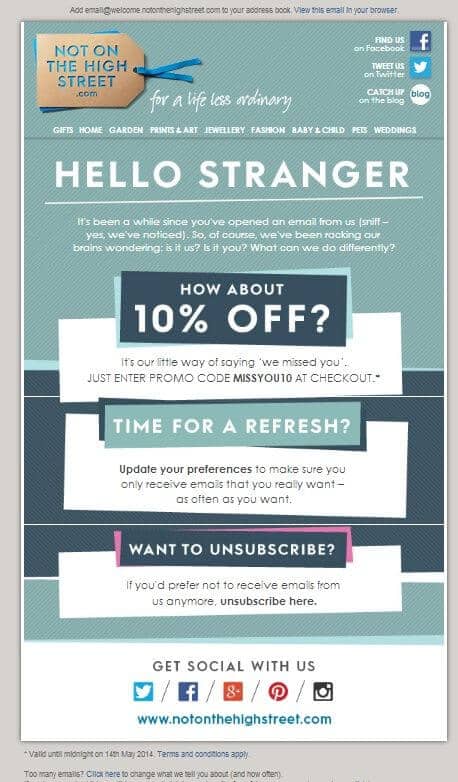
3. Show your subscribers you’ve changed ways.
You may not have realized it but perhaps your website needs a makeover. Or maybe your email template needs a bit of color and snazzy copy. Some subscribers may have forgotten about you because you have been not paying attention to your own brand voice.
To spice things up, go get a makeover and broadcast these new changes while re-engaging your subscribers at the same time. Think of it as a way to remind them you’re still around and you are willing to change to make the relationship work.
This re-engagement email from StruckAxiom reminds inactive leads they’ve created a whole new site for them to visit and explore.
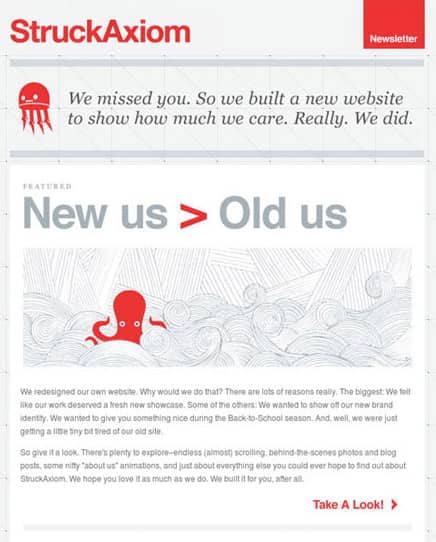
4. Ask for feedback.
It’s likely your emails are not meeting your subscribers’ expectations. After properly segmenting your email list based on demographics or previous purchases, consider asking if there’s something you can do to improve the email experience the next time you send re-engagement emails.
This strategy works well with a freebie or with a discount on the next purchase. For example, “Fill out our one-question survey and get 20 percent off your next order.”
Check out the following re-engagement emails surveys below.
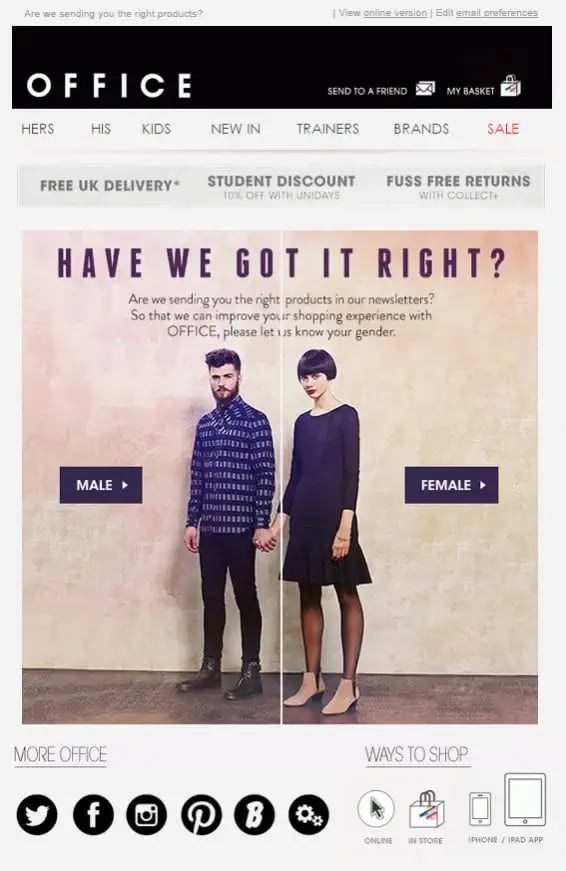
.png?width=513&name=wedding_wire%20(1).png)
5. Let them go—but not before you offer other options to get in touch with you.
If you’ve done everything from reminding subscribers of the value you offer to discounts with significant value, consider letting them go at this point. Since you’ve given them plenty of chances to regain their interest, it’s about time you bid them adieu. Inactive subscribers will only hurt your existing email marketing analytics and negatively impact your efforts.
Before you completely say goodbye, give them an option to get in touch with you and receive future offers via other channels. Habitat’s re-engagement email is a great example.
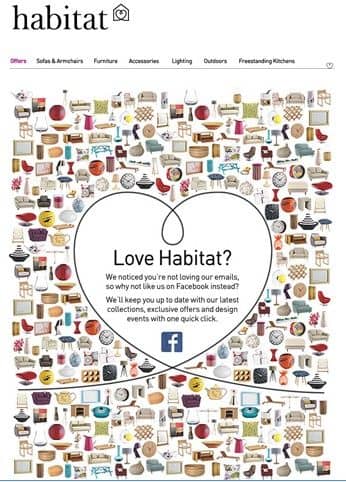
Quick note: Don’t immediately remove people who don’t respond to re-engagement email. According to Return Path’s recent study on email win-back programs, it takes roughly 2 months for a subscriber to read a win-back email.
Pick Yourself Up from the Loss
While prospects who unsubscribed may be a huge disappointment, pick yourself up from the loss and continue to focus on providing meaningful content and solutions to your prospects and customers. Like all types of relationships, it all boils down to trust.
Which email re-engagement strategy are you keen about?
Kyjean Tomboc finished nursing school but found joy in plucking and stringing words to create value-driven content for brands in the health, life sciences, and lean startup niches. She loves everything strategic in creating content -- from CRO to SEO to SMM to UX (the Internet sure loves acronyms!). Her current obsessions include the human gut microbiome, A/B testing, and Benedict Cumberbatch. Kyjean is also a seasoned trekker.








.png?width=513&name=wedding_wire%20(1).png)

